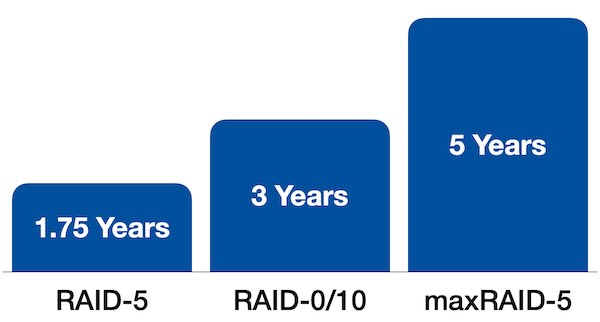Executive Summary
RAID-5 configurations, while providing redundancy and data protection, can severely reduce the lifespan of SSDs. Workloads that typically exhaust SSDs in 3 years under RAID-0 or RAID-10 setups can shorten their lifespan to just 1.75 years in an 8-drive RAID-5 array.
This white paper explores:
- Why SSD wear accelerates in RAID-5.
- The role of inefficient writes and parity overhead.
- How innovative solutions like maxRAID address these limitations.
The Problem: SSD Wear in Parity RAID
Traditional RAID-5 accelerates SSD wear with inefficient writes. This applies to any RAID-5 solution without write linearization, including:
- Linux MD RAID-5
- Hardware RAID
- Xinnor – xiRAID
- GRAID – SupremeRAID

Lifespan impact on SSD
Unlike traditional RAID-5 solutions, maxRAID incorporates advanced write linearization techniques to enhance storage efficiency and endurance. Solutions such as Pliops XDP/RAIDplus also employ comparable strategies.
The Technical Analysis: SSD Write Patterns
In a single SSD or RAID-0 (striped) setup, each IO writes directly to the SSD without added overhead, maintaining a 1:1 data-to-drive relationship. This setup is a baseline for gauging SSD wear and demonstrates how drives withstand intensive workloads. For instance, if your SSDs last three years in RAID-0, you can better predict their lifespan in a more complex RAID-5 setup.
RAID-5 Lifespan Calculation
The formula for SSD lifespan under RAID-5 is:

In our example:

The “/2” factor in RAID-5 indicates two writes for each non-linear operation—one to the data disk and one to the parity disk—doubling the workload. The “x 8/7” adjustment reflects a specific array configuration, where only seven disks contribute to usable capacity due to parity.
Unlike RAID-0, RAID-5 adds parity overhead, which increases write amplification and wear. This underscores the importance of understanding how data flows and workloads impact SSD longevity in different RAID configurations. This understanding enables better decisions to balance performance, endurance, and cost.
Does this always apply? If the RAID layer isn’t linearizing writes, this scenario unfolds. Linear writes require efficient block mapping. Due to RAID’s parity protection mechanism, extra writes are inevitable without a Block Translation Layer.
The Solution: maxRAID and Block Translation Layer
maxRAID overcomes RAID-5 limitations by introducing an advanced Block Translation Layer. It:
- Linearizes Writes: Converts random writes into precisely aligned sequential patterns.
- Reduces Write Amplification: Minimizes unnecessary parity writes.
- Enhances Compression: Increases storage capacity and boosts performance.
- Extends SSD Lifespan: Reduces wear by managing workloads more efficiently.
MaxRAID ensures unmatched efficiency and reliability for demanding workloads by seamlessly integrating into virtual environments and file systems.
Conclusion
RAID-5, while offering redundancy, accelerates SSD wear due to inefficient writes and parity overhead. Organizations relying on RAID-5 risk shorter SSD lifespans, higher replacement costs, and degraded performance.
maxRAID revolutionizes RAID configurations with intelligent mapping, compression, and linearized writes. By extending SSD life to 5 years and optimizing performance, maxRAIDdelivers the efficiency modern workloads demand.
Download Our White Paper
Please provide your email address to receive the link to download the white paper. Your information will help us keep you updated with the latest insights and innovations.

